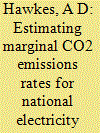| Srl | Item |
| 1 |
ID:
098651


|
|
|
|
|
| Publication |
2010.
|
| Summary/Abstract |
The carbon dioxide (CO2) emissions reduction afforded by a demand-side intervention in the electricity system is typically assessed by means of an assumed grid emissions rate, which measures the CO2 intensity of electricity not used as a result of the intervention. This emissions rate is called the "marginal emissions factor" (MEF). Accurate estimation of MEFs is crucial for performance assessment because their application leads to decisions regarding the relative merits of CO2 reduction strategies. This article contributes to formulating the principles by which MEFs are estimated, highlighting the strengths and weaknesses in existing approaches, and presenting an alternative based on the observed behaviour of power stations. The case of Great Britain is considered, demonstrating an MEF of 0.69 kgCO2/kW h for 2002-2009, with error bars at +/-10%. This value could reduce to 0.6 kgCO2/kW h over the next decade under planned changes to the underlying generation mix, and could further reduce to approximately 0.51 kgCO2/kW h before 2025 if all power stations commissioned pre-1970 are replaced by their modern counterparts. Given that these rates are higher than commonly applied system-average or assumed "long term marginal" emissions rates, it is concluded that maintenance of an improved understanding of MEFs is valuable to better inform policy decisions.
|
|
|
|
|
|
|
|
|
|
|
|
|
|
|
|
| 2 |
ID:
125692


|
|
|
|
|
| Publication |
2013.
|
| Summary/Abstract |
The idea of using less productive or "marginal land" for energy crops is promoted as a way to overcome the previous land use controversies faced by biofuels. It is argued that marginal land use would not compete with food production, is widely available and would incur fewer environmental impacts. This term is notoriously vague however, as are the details of how marginal land use for energy crops would work in practice.
This paper explores definitions of the term "marginal land" in academic, consultancy, NGO, government and industry documents in the UK. It identifies three separate definitions of the term: land unsuitable for food production; ambiguous lower quality land; and economically marginal land. It probes these definitions further by exploring the technical, normative and political assumptions embedded within them. It finds that the first two definitions are normatively motivated: this land should be used to overcome controversies and the latter definition is predictive: this land is likely to be used. It is important that the different advantages, disadvantages and implications of the definitions are spelled out so definitions are not conflated to create unrealistic expectations about the role of marginal land in overcoming biofuels land use controversies.
|
|
|
|
|
|
|
|
|
|
|
|
|
|
|
|